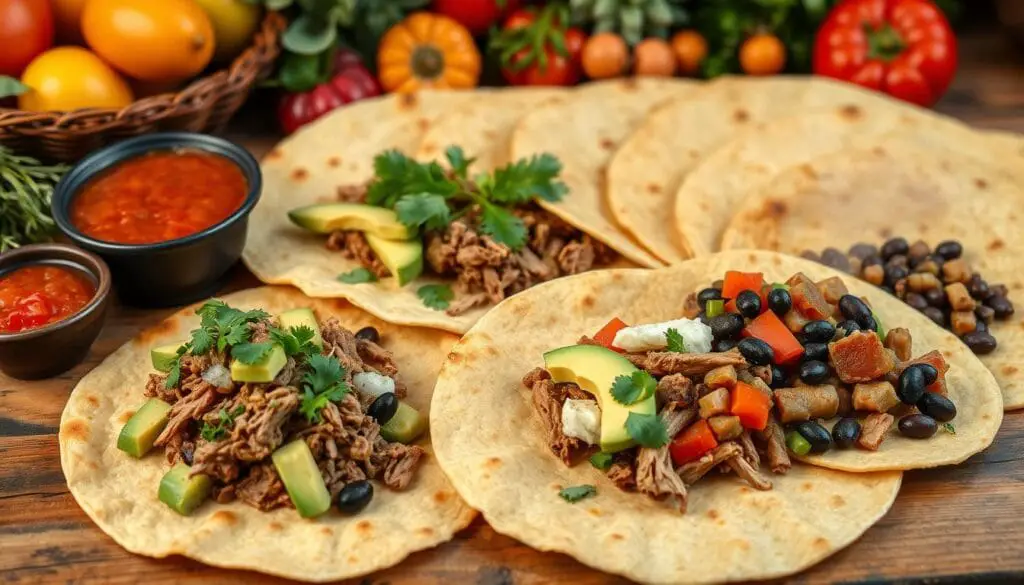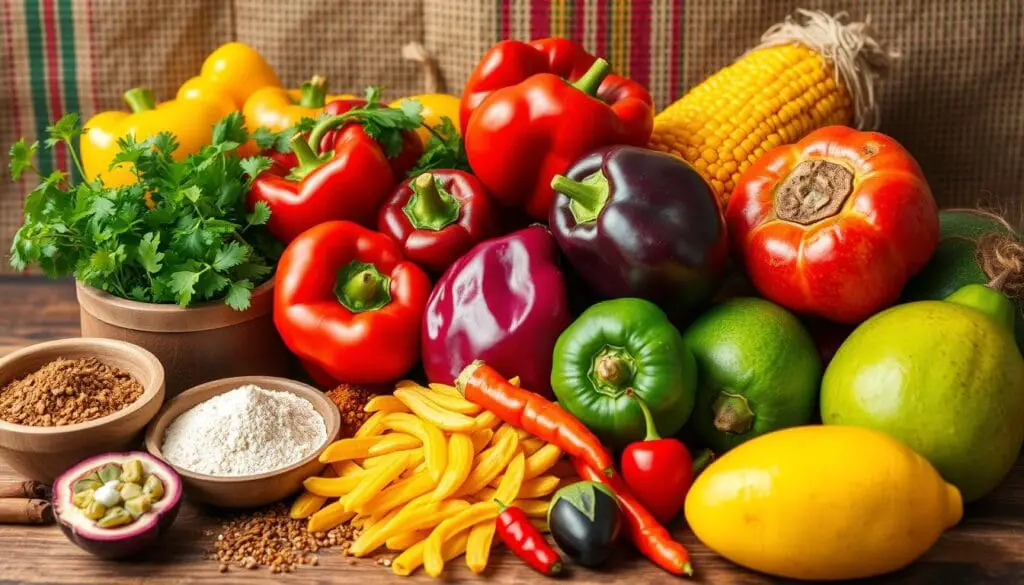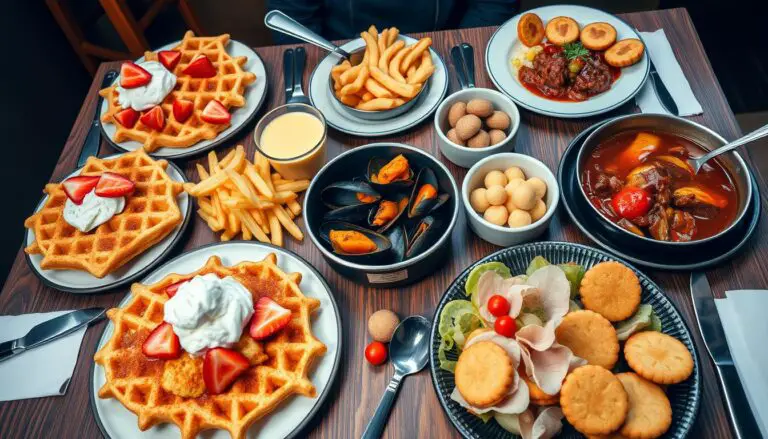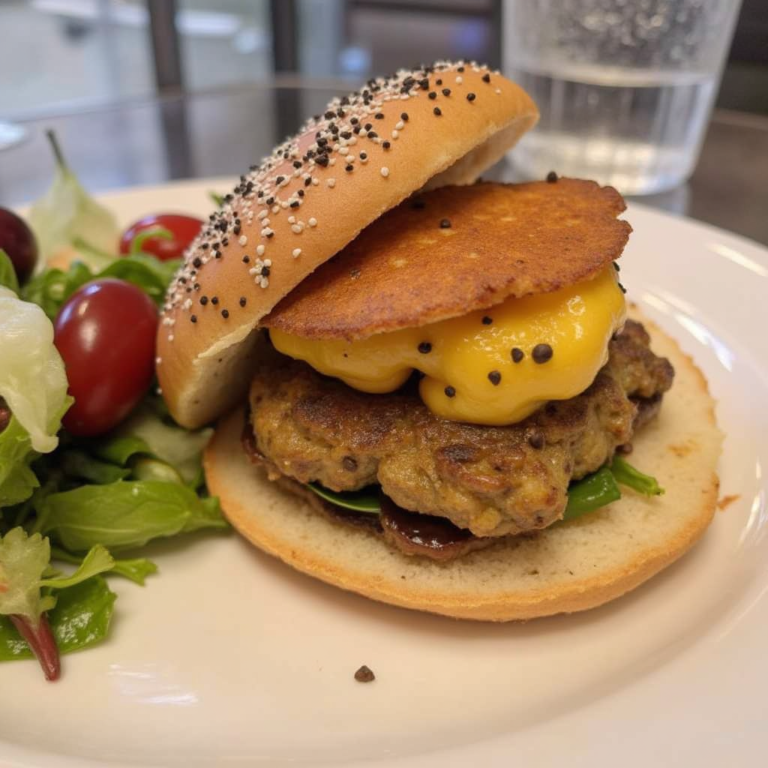5 Must-Try South America Food Dishes That Will Delight Your Taste Buds
Walking through Buenos Aires, I was drawn by the smells of sizzling meat and the sounds of people talking. It showed me the heart of South American food – a mix of flavors, traditions, and respect for the earth. From Peru’s zesty ceviche to Brazil’s hearty feijoada, each country has its own food journey to share.
South America’s food scene is a blend of cultures, with dishes that show the mix of indigenous, European, and African traditions. As you explore, get ready for bold, surprising, and delicious tastes. Let’s look at 5 South American dishes that will make your taste buds happy and leave you wanting more.
Table of Contents
Understanding the Rich Culinary Heritage of South American Cuisine
South American cuisine is a vibrant mix of cultures. It includes indigenous traditions, colonial legacies, and global trends. This mix shows the region’s dynamic history, with local ingredients, traditional recipes, and new cooking methods.
Cultural Influences on South American Gastronomy
The pre-Columbian era greatly influenced South American food. Crops like potatoes, maize, and beans are key to many dishes. The colonial era brought in European ingredients, blending flavors and techniques.
The Andean region, including Peru, Bolivia, and Ecuador, focuses on native ingredients. In contrast, the Amazon basin, covering Brazil, Venezuela, and Colombia, is known for tropical fruits and fish.
Regional Variations and Traditional Cooking Methods
South America’s cuisine varies by region, each with its own traditions. The Pampas region of Argentina and Uruguay is famous for its beef and asado. The Caribbean coastal areas blend indigenous, European, and African flavors, with seafood and coconut being key.
Traditional cooking methods across the continent reflect the diverse landscapes and cultures. Grilling is common in the Pampas, while steaming and boiling are used in the Andes. Smoking and drying are popular in the Amazon. These methods help preserve the authentic flavors and cultural heritage of South American food.
| Region | Dominant Influences | Signature Dishes |
|---|---|---|
| Andean | Pre-Columbian, Indigenous | Potatoes, Aji Chili Peppers, Corn |
| Amazon Basin | Tropical, Indigenous, African | Tropical Fruits, Fish, Cassava |
| Pampas | Ranching, Beef-Centric | Asado (Barbecue) |
| Caribbean Coast | Indigenous, European, African | Seafood, Coconut, Plantains, Rice |
The rich culinary heritage of South America shows the region’s vibrant culture. Traditional recipes, indigenous ingredients, and cooking methods blend to create a diverse and captivating food landscape.
The Art of South America Food: From Street Vendors to Fine Dining
South American food culture is a fascinating mix of street food and fine dining. The continent is full of street food with its own special flavors. Empanadas, arepas, and churros are loved by many and are key to South America’s culinary traditions.
But there’s more to South America’s food than street food. Fine dining places show off the region’s cooking skills. They use traditional ingredients in new, fancy dishes. This highlights the flavor profiles of the land.
From Lima’s creative chefs to the farm-to-table movement, South America’s food is diverse. It caters to all kinds of tastes and preferences.
South America’s culinary scene is diverse and vibrant, ranging from street vendors to fine dining establishments, showcasing the continent’s rich gastronomic identity.
Whether you love the buzz of markets or the elegance of Michelin-starred restaurants, South America’s food is a journey. It opens a window into the region’s culture and its changing food scene.
Peruvian Ceviche: A Fresh and Zesty Seafood Delicacy
Ceviche is Peru’s iconic dish, showing the country’s rich food culture and its connection to the Pacific Ocean. It’s made with raw fish or shellfish marinated in citrus juices like lime, onions, chili peppers, and cilantro. This makes the fish taste fresh and zesty.
Traditional Preparation Techniques
Peruvian ceviche starts with the freshest seafood, like sea bass or halibut. It’s cut into small pieces and mixed with red onions, aji amarillo, and cilantro. Then, it’s marinated in lime or lemon juice, blending flavors in a bright and refreshing way.
Regional Variations of Ceviche
Peru’s ceviche has different flavors in different places. The north adds coconut milk for creaminess. The south includes sweet potatoes or corn for texture. Inland, freshwater fish like trout or paiche are used, showing ceviche’s adaptability.
Best Ways to Enjoy Ceviche
- Enjoy ceviche as a refreshing appetizer or light meal with sweet potatoes, cancha, and lettuce or cabbage.
- Try it with a pisco sour, Peru’s national cocktail, for a true Peruvian taste.
- Pair ceviche with dishes like lomo saltado or ají de gallina for a full Peruvian meal.
Ceviche is a must-try for anyone wanting to taste Peru’s diverse flavors. Whether by the Pacific or in a city, it’s a memorable experience.
Argentine Asado: The Ultimate Grilled Meat Experience
Seeking a memorable food adventure? Look no further than the iconic Argentine asado. It’s more than a meal; it’s a key part of Argentina’s rich culinary traditions. The sizzling grilling techniques and the flavor profiles of the argentine specialties make it a true feast.
The asado focuses on simple, yet sublime, meat preparation. Beef, pork, and chicken are seasoned with coarse salt, letting their natural flavors stand out. This shows the Argentines’ love for quality and traditional recipes of their beloved beef.
| Asado Grilling Tips | Recommended Values |
|---|---|
| Grill Height from Fire | 15-20 cm |
| Meat Cooking Time | 6-11 seconds per side |
| Meat Temperature Before Grilling | Room temperature |
| Meat Texture for Doneness | Soft, elastic, firm |
| Grill Cleaning Frequency | Before each meat cut |
The asado’s communal aspect is just as vital as the food. Families and friends gather, enjoying Malbec wine and lively chats. Sharing a grilled steak or sausage shows the Argentines’ love for culinary traditions and togetherness.
An asado is not just a meal, it’s a way of life in Argentina. The aroma of the grill, the sound of sizzling meat, and the laughter of loved ones – it’s a symphony of flavor profiles and memories that can’t be replicated anywhere else.
Want to dive into Argentine grilling techniques and culinary traditions? An asado is an experience you won’t want to miss. Grab Malbec, gather friends and family, and enjoy the ultimate argentine specialties like a true porteño.
Brazilian Feijoada: A Hearty Black Bean Stew
Feijoada is Brazil’s national dish, loved by many. It’s a rich black bean stew with pork and beef, including ears, tails, and feet. Sausage and bacon are also added, all slow-cooked to perfection. This dish shows the rich brazilian cuisine and its deep traditional recipes.
Essential Ingredients and Preparation
Authentic feijoada starts with the right ingredients and careful preparation. It uses black beans, pork, beef, bacon, and smoked sausage. These are simmered for hours to create a rich, hearty stew.
The cooking method is key. First, the meats are browned for flavor. Then, they simmer longer to tenderize and infuse the beans with savory flavors. This slow-cooking brings out the best of regional cuisines and culinary traditions.
Traditional Serving Suggestions
Feijoada is served with various sides to enhance its flavors and textures. These include white rice, collard greens, farofa (toasted cassava flour), and sliced oranges. These sides add to the dish’s appeal, making each bite a celebration of brazilian cuisine.
Feijoada is a favorite for weekend meals, bringing families and friends together. It’s a time for enjoying good food and lively conversations. This highlights the role of food in Brazilian culture, bringing people together.
Venezuelan Arepas: Versatile Cornmeal Patties
In South America, Venezuelan arepas are a favorite. These cornmeal cakes are a key part of Venezuelan food culture. They are made from ground maize, shaped into patties, and cooked until crispy.
Arepas can be filled in many ways. Each area in Venezuela has its own favorite fillings. You can find everything from cheesy to bean-filled arepas.
Arepas have a long history in Venezuela. They connect people to Latin America’s traditions and tastes. Enjoy them at any time of day, and you’ll see why they’re so special.
| Arepa Variation | Description |
|---|---|
| Reina Pepiada | Filled with shredded chicken, avocado, and mayonnaise |
| Arepa de Pabellón | Filled with shredded beef, black beans, white cheese, and plantains |
| Arepa de Queso | Filled with melted white cheese |
| Arepa de Choclo | Made with fresh corn and filled with white cheese |
| Arepa con Huevo | Filled with a fried egg |
Arepas are tasty and gluten-free. They’re perfect for trying venezuelan gastronomy or looking for new street food. Venezuelan arepas will make your taste buds happy and introduce you to Latin America’s rich food traditions.

Colombian Bandeja Paisa: A Complete Meal on One Plate
Explore the rich flavors of Colombian cuisine with the Bandeja Paisa. This dish comes from the Antioquia region. It’s a feast for the senses, blending colombian flavors and traditional recipes on one plate.
Components of the Perfect Bandeja Paisa
The Bandeja Paisa is a culinary masterpiece. It features a mix of ingredients:
- Grilled steak
- Chicharrón (fried pork belly)
- Chorizo (Colombian sausage)
- Fried egg
- Avocado
- Arepa (corn patty)
- Rice
- Red beans
- Plantains
This mix of regional cuisines and culinary traditions makes for a satisfying meal. It highlights the variety and richness of Colombian food.
Regional Variations and Serving Customs
While the Bandeja Paisa’s core stays the same, regional variations exist. Different areas add their own touches based on local tastes and what’s available. The way it’s presented and served also shows the unique flavor profiles and culinary traditions of each region.
Bandeja Paisa is a true celebration of the diverse and vibrant colombian flavors that have been passed down through generations.
Essential Ingredients in South American Cooking
South American cuisine is rich and diverse, thanks to indigenous ingredients and local produce. From the Andes to the Amazon, the region celebrates its culinary heritage. It honors the land’s bounty.
At the core of South American dishes are corn, potatoes, quinoa, and beans. These staples have been grown for centuries. They form the base of many Latin American dishes, adding nutrition and flavor.
- Colombian cuisine uses staple crops like potatoes, corn, beans, cassava, rice, and tomatoes. All but rice are native to Colombia.
- Spanish conquerors introduced chicken, pork, and beef to Colombian cuisine. These meats are still popular in restaurants and homes.
- The Caribbean coastline of Colombia influences its seafood dishes.
South American cooking also features a wide range of tropical fruits. Tamarillos, strawberry guavas, pineapple guavas, cherimoyas, starfruit, mamey, and ice cream beans add unique flavors and textures to dishes and drinks.
Spices and herbs are key in South American cuisine. Chili peppers, like Peru’s aji amarillo, add bold flavors. Cilantro, parsley, and other herbs are common in many dishes.
Check Out These Posts:
- Food Tour San Diego: Savor the Best of Southern California’s Culinary Scene
- 10 Best Half Moon Bay California Restaurants for an Unforgettable Dining Experience
- Food Tour Amsterdam: Discover the Culinary Treasures of the Dutch Capital
| Ingredient | Contribution to South American Cuisine |
|---|---|
| Black Pepper | A key ingredient in Colombian dishes, used to balance flavors and enhance the natural sweetness of vegetables. |
| Cumin | Introduced by European colonists, cumin is a warm spice used in combination with onion, garlic, and other spices to create a base for many Colombian dishes. |
| Allspice | Native to South America, allspice is used in Colombian cooking to add clove, cinnamon, and nutmeg flavors to both sweet and savory dishes. |
| Cinnamon | Brought by European settlers, cinnamon is a common spice in Colombian cuisine used in both sweet desserts like natilla and savory dishes. |
Sauces and condiments are vital in South American cooking. They showcase the region’s local produce and diverse flavor profiles. From Peru’s aji verde to Argentina’s earthy chimichurri, these accompaniments enhance the essential ingredients of South American cuisine.

Where to Find Authentic South American Cuisine in Major Cities
South American cuisine is a treasure trove of flavors and traditions. You don’t need to travel far to taste these delights. Major cities worldwide, especially in the US, offer authentic South American food.
In the US, Miami, New York, and Los Angeles have many South American restaurants. Look for places that focus on specific countries or regions. Also, check out food festivals that celebrate South American culture.
For the best experience, choose restaurants run by South American immigrants. These places offer real flavors and insights into South American cooking.
Exploring South American Cuisine in the US
- Miami is a hub for Cuban, Brazilian, and Colombian food. Neighborhoods like Little Havana and Wynwood have many street foods, cafes, and fine dining spots.
- New York City has a vibrant South American food scene. You can find Peruvian ceviche bars, Argentine steakhouses, Brazilian churrascarias, and Venezuelan arepería.
- Los Angeles has a large South American immigrant population. Neighborhoods like East LA and Koreatown offer a variety of cuisines, from Bolivian salteñas to Ecuadorian encebollado.
Whether you want Argentine asado, Peruvian ceviche, or Brazilian feijoada, US cities offer a culinary journey. You can explore the vibrant tastes of South America in these cities.
| Dish | Origin | Description |
|---|---|---|
| Parrilla | Uruguay and Argentina | A selection of grilled meats, including morcilla (blood sausage), chorizo (sausage), and asado de tira (short ribs), served in establishments called parrillas or steakhouses. |
| Feijoada | Brazil | A traditional stew made of black beans, smoked pork, and pork spareribs, often enjoyed on Saturdays in Brazil with samba, bossa nova, or while watching football. |
| Dry Aged T-Bone Steak | Argentina | Renowned for its tenderness and flavor due to the dry aging process, offered at a fraction of the cost compared to the United States. |
| Salchipapas | Ecuador and Peru | A street food consisting of fried hot dogs served with French fries, topped with ketchup and local sauces, found throughout Ecuador and Peru. |
| Caldo de Gallina | Peru | A Peruvian chicken soup comprising noodles, a piece of tough chicken or hen, and a hard-boiled egg, commonly found at establishments like the food section of San Pedro Market in Cusco. |
Conclusion
South American cuisine is a mix of flavors, ingredients, and traditions. It shows the continent’s diverse cultures and landscapes. From lively street food to fancy fine dining, it’s a unique food journey.
Exploring dishes like Peruvian ceviche, Argentine asado, and Brazilian feijoada deepens our appreciation. It highlights the culinary heritage and food’s role in South American culture and society.
The flavor profiles come from mixing pre-Hispanic and European influences. This mix has created many regional cuisines. Each country’s south america food specialties reflect its unique ecosystems and traditions.
As South American cuisine gains more fans worldwide, its impact will grow. It will bring new tastes and keep its traditional roots. Exploring its culinary traditions is rewarding. It celebrates the region’s heritage and the power of food to unite people.
FAQ
What are some must-try South American food dishes?
You should try Peruvian ceviche, Argentine asado, and Brazilian feijoada. Venezuelan arepas and Colombian bandeja paisa are also must-haves.
How has South American cuisine been influenced by different cultures?
South American food is shaped by many cultures. These include indigenous, European, African, and Asian influences. These have created the unique tastes and cooking styles across the continent.
What are some traditional cooking methods in South American cuisine?
Grilling, slow-cooking, and marinating are key in South American cooking. Ingredients like quinoa, potatoes, and corn are also used a lot.
Where can you find authentic South American cuisine in major cities?
Cities like Miami, New York, and Los Angeles have great South American food. Look for restaurants run by locals or food festivals celebrating South American culture.
What are the key ingredients used in South American cooking?
Corn, potatoes, quinoa, and beans are staples. Tropical fruits, chili peppers, and herbs like cilantro are also common. The choice of ingredients changes by country and region.
Source Links
- The Most Iconic Dish From Each South American Country | Eclipse Travel – https://eclipsetravel.com.au/iconic-dishes-from-south-america/
- Top 5 Must-Try South American Street Food – Street Eats & Soul Food America – Food Blogger Max – https://foodbloggermax.com/south-american-street-food/
- South American Cuisine: Fusion of Indigenous & Colonial Tastes – https://twq.ygn.mybluehost.me/south-american-cuisine-fusion-of-indigenous-colonial-tastes/
- The Importance of Food in South American Festivals – https://amazingfoodanddrink.com/food-in-south-american-festivals/
- A Guide to the Best Local Food in South America – Travel Blog – https://www.travelgumbo.com/2024/07/07/a-guide-to-the-best-local-food-in-south-america/
- Discover the Culinary Wonders of Latin America – From Markets to Michelin Stars on a Tailored Journey with OROKO Travel – https://www.thetaste.ie/discover-the-culinary-wonders-of-latin-america-by-oroko-travel
- Peru: A Foodie’s Paradise – https://bestperutours.com/peru-a-foodies-paradise/
- A Guide to Peruvian Cuisine | Jacada Travel – https://www.jacadatravel.com/latin-america/peru/travel-guides/guide-to-peruvian-cuisine/
- Discover the Best Peruvian Food: Must Try Traditional Dishes in Peru – K’anchay Peru Travel – https://kanchayperutravel.com/best-peruvian-foods-dishes/
- Eating in Buenos Aires: From Traditional Asados to Michelin Marvels – Eat & Travel – Food nerd rockstar – https://www.foodnerdrockstar.com/eat-and-travel/eating-in-buenos-aires-from-traditional-asados-to-michelin-star-marvels
- Cooking Argentine Asado – Learn About History and Recipes | Vamos Academy – https://vamospanish.com/discover/everything-you-need-to-know-about-argentinian-asados-bbq/
- The real guide to prepare Argentine asado – https://pampadirect.com/blog/the-real-guide-to-prepare-argentine-asado/?srsltid=AfmBOorQc-qWKQ9Eak-dCwl58Zh3btw75WwzPEhA4EEM0uwhOKDyMtwW
- Feijoada (Brazilian Black Bean Stew) – https://www.daringgourmet.com/feijoada/
- Feijoada (Brazilian Black Bean Stew) Recipe • Curious Cuisiniere – https://www.curiouscuisiniere.com/feijoada-brazilian-black-bean-stew/
- Feijoada – https://www.tasteofhome.com/recipes/my-brazilian-feijoada/?srsltid=AfmBOorJc-o1W7hatYroLSIVk1pf6hvPzVHzBvgUqn6pCnqDWAbUH9Wh
- Arepas – The best street food snack – https://vanlifeeats.com/arepas-street-food-of-south-america/
- Arepas Recipe – https://www.chilipeppermadness.com/recipes/arepas/
- 3-Ingredient Arepas – The Big Man’s World ® – https://thebigmansworld.com/arepas-recipe/
- Gastroregionalism in Colombia: Enforcing Paisa Culture Through “Traditional Food” – https://gradfoodstudies.org/2024/09/18/gastroregionalism-in-colombia/
- What are the most popular Colombian foods? – https://www.tryotter.com/resource/wiki/popular-colombian-food
- Colombian cuisine: 90 traditional food dishes & drinks to try – https://www.berlitz.com/blog/colombian-food-cuisine-dishes
- Colombian Spices: Spice Up Your Trip to Colombia – Traveling with MJ – https://www.travelingwithmj.com/colombian-spices-spice-up-your-trip-to-colombia/
- 14 Sauces From South America You Should Try At Least Once – Tasting Table – https://www.tastingtable.com/1511118/south-american-sauces-explained/
- 7 Essential Ingredients for Cooking Great Mexican Food, According to Eva Longoria – https://www.aol.com/7-essential-ingredients-cooking-great-192300794.html
- Best South American Foods to Try When Traveling – https://www.gocollette.com/en/traveling-well/2024/06/best-south-american-foods-try-when-traveling
- Top South American Destinations for Solo Expats – https://www.greenbacktaxservices.com/blog/top-south-american-destinations-for-solo-expats/
- Why this is Latin America’s next dining destination | CNN – https://www.cnn.com/2024/05/28/travel/bolivia-cuisine-top-restaurants-dishes/index.html
- South American cuisine: 130 dishes from 12 countries to try – https://www.berlitz.com/blog/south-american-cuisine-food-dishes
- Food Security in Latin America and the Caribbean – https://www.iadb.org/en/news/food-security-latin-america-and-caribbean
- Exploring Latin American Cuisine’s Rich Flavors – https://socialstudieshelp.com/exploring-latin-american-cuisines-rich-flavors/







